Why Does Big Toe Hurt After Running
Author:
Unlock your full potential by engaging with our experts and community! Have questions about your fitness journey or looking for expert advice on weightlifting techniques? Don’t hesitate — leave a comment below and Ernesto Mendez will provide a personalized answer and insights to help you reach your goals.
Torokhtiy is reader-supported. Some links are affiliate links, and we may earn a commission at no extra cost to you. See our disclosure page for details.
Runners tend to worry about injuries to large body parts like hips and knees but forget that even when small joints like the big toe hurts after running, it can slow you down for days. The big toe might be a small joint, but it holds an essential value for runners.
It plays a critical role in creating more leverage during walking, and running keeps pushing them forward. The purpose of being responsible for this movement makes it more susceptible to various injuries.
Even though this issue is rare among runners, we must pay attention to those who deal with it. If you are also experiencing this type of pain, you must ask yourself why your big toe joint hurts after running. In this article, we’ll answer this question and inform you about the main symptoms, conditions, and treatments of significant toe pain after running.
Why Does Big Toe Hurt After Running? – Besides the basics, such as lousy running form, improper tight shoes, and long-distance runs, you may need a runner toe treatment for any medical condition. The case may be sesamoiditis, bunions, or hallux rigidus and plantar fasciitis.
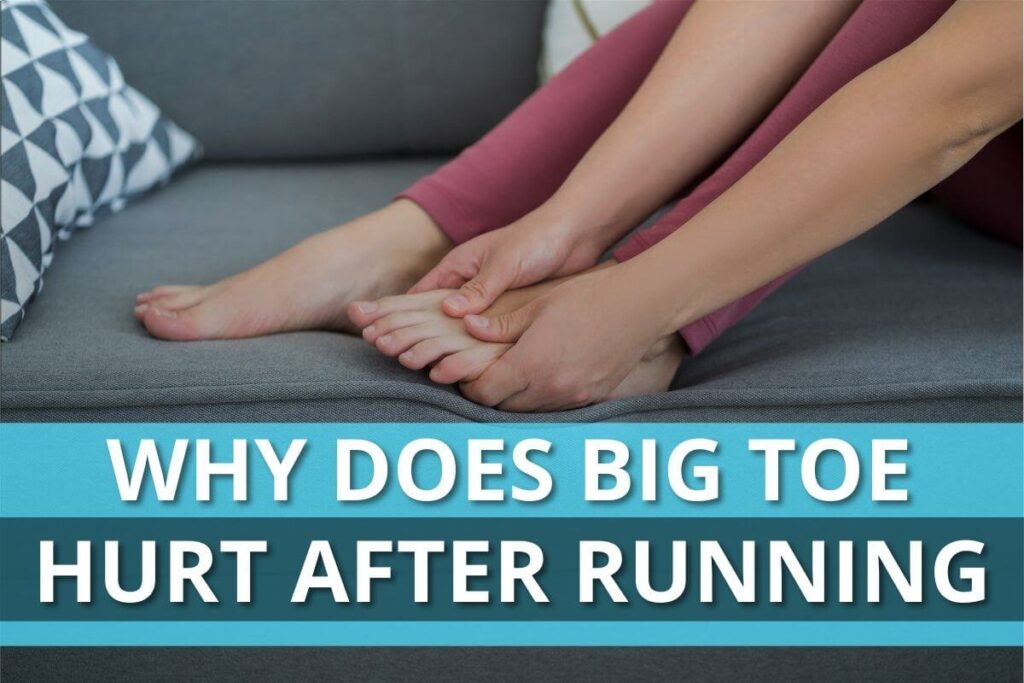
Anatomy Of The Big Toe Joint
The big toe consists of two joints. The bigger of the two is the metatarsophalangeal joint. This is where the first long bone of the foot (metatarsal) connects with the first bone of the toe (phalanx). Even though it’s pretty tiny, the big toe joint’s anatomy has more than just two bones articulating at the metatarsophalangeal joint (MTP).
Since it handles so much force during running, the big toe joint has necessary adaptations that help your overall running mechanics. We’ll mention tiny bones called sesamoids here that protect your toes from the pressure of weight and give you the advantage of multiplying your force while running.
However, sesamoids are so small that the ligaments and tendons surrounding them are much more vulnerable and prone to injury. That leads to a sore big toe after running and possible inflammation of the sesamoid bones – sesamoiditis. This condition is commonly known as “turf toe” and is one of the reasons why your toes hurt from running.
The big toe pain experienced by runners can vary in sensation and triggers. For example, some might get sharp, stabbing pain; for others, it may manifest as a burning feeling. Also, the toe feels tender to touch, and activities like sprinting might worsen it.
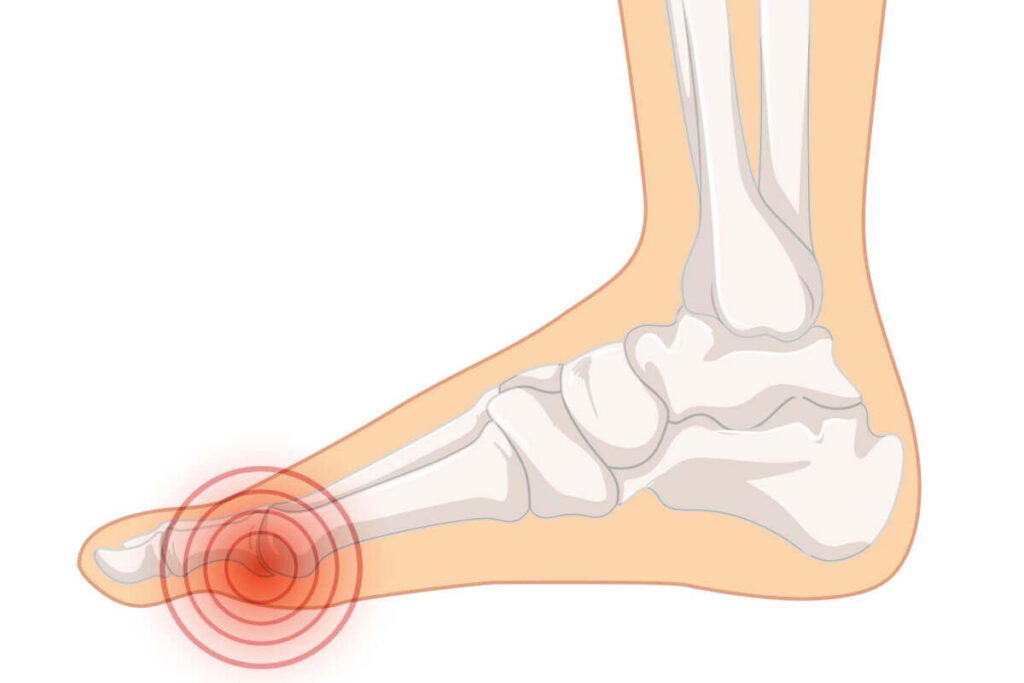
Why Does The Big Toe Joint Hurt From Running?
Running big toe pain can occur due to various reasons. It’s always important to define the underlying cause to address it adequately. If your big toe joint hurts after running, you may be wearing improper or worn-out running shoes that can’t give you enough support. Pain in the big toe when running may also indicate hip pain.
When running, you may deal with big toe pain when having muscle imbalance, tight muscles, or weakness in the lower extremities that puts extra pressure on your toes. Also, big toe pain after running long distances can be a case.
7 Main Reasons Why The Big Toe Hurts After Running
Here, we come to the main reasons your big toe hurts when running. Let’s review all the possible causes, including sprains, arthritis, fractures, tendon inflammation, and bunions.
1. Sesamoiditis
Sesamoiditis is the inflammation in the tendons surrounding the sesamoid bones. It often results from fractures of the sesamoid bones and overuse of the toe. This condition causes pain at the base of the big toe. It will gradually develop over time, and you may notice it when your toe becomes extremely sensitive while bent or straightened.
The affected sesamoiditis will be incredibly tender to the touch. Speed training, increasing mileage, and hill repeats may contribute to this problem. Sesamoiditis can usually be resolved in two to four weeks. A bone scan is often needed to diagnose this issue.
On the other hand, it is prevalent for one of the sesamoid bones to occur in two pieces naturally. This does not cause pain but will create a challenge if a sesamoid fracture is suspected.
2. Bunions
A bunion is a bony bump on the inside of the big toe. It may leave your toe sore after running, and it happens due to an abnormal joint alignment. The soft tissues over the bump may also swell, making it even larger. What happens here is the big toe moves outward, and in various cases, it may even move under the second toe.
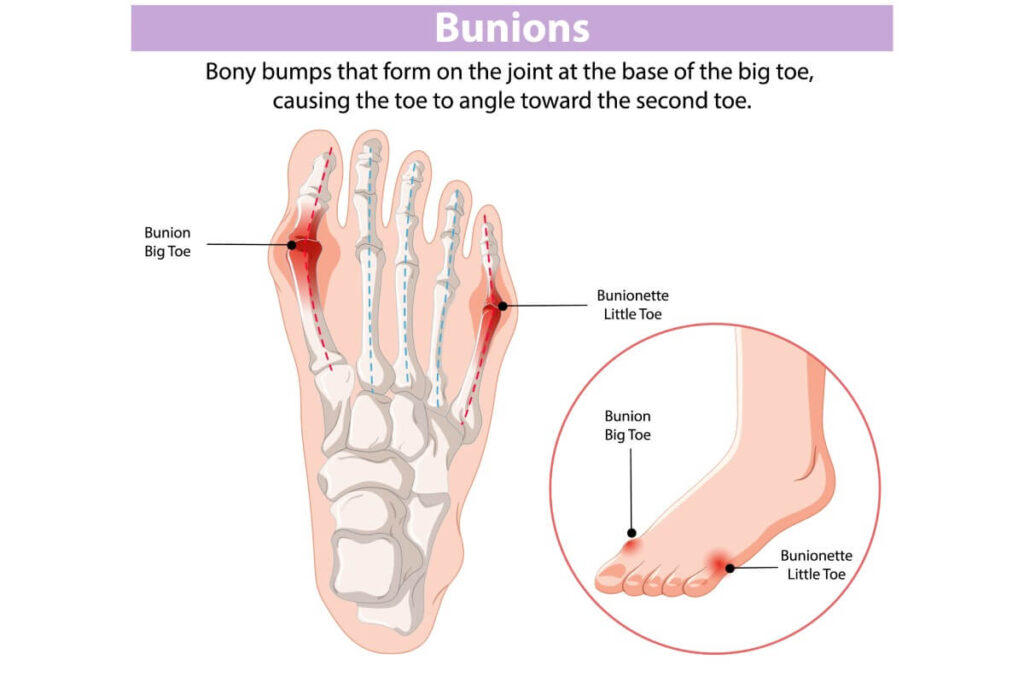
If you’re experiencing pain in the big toe when running due to bunions, be aware that they can become more prominent over time if not dealt with properly. Bunions can cause swelling, tenderness, and pain around the big toe joint.
Bunions are not very painful, and you can control them simply by wearing a shoe that will provide enough space to accommodate the deformity.
3. Toe Injuries
Toe fractures and sprains may also cause swelling and pain in the big toe joint; thus, it may be excruciating while running or even walking. Sprains occur when we have stretched or torn ligaments in the big toe joint.
Additionally, they can significantly reduce the range of motion. Toe injuries from running happen for various reasons, including turf toe, the most significant sports injury due to excessive or repetitive pressure on a bent toe.
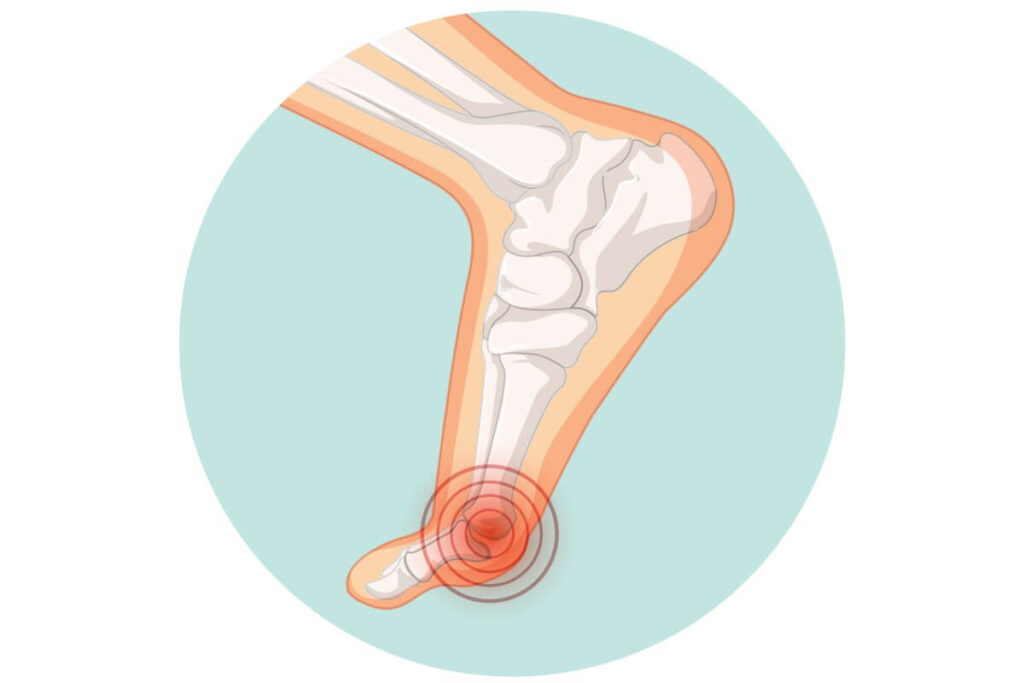
There are chronic or acute fractures. An acute fracture happens immediately at the time of injury, and a chronic one can come and go and worsen with time. Moreover, toe injuries include stress fractures – a small crack in the bone that develops due to a continuous force. Besides this, toe fractures may also occur due to a single and intense blow to the toe area.
4. Hallux Rigidus/Osteoarthritis
If you’re having pain in big toe after running, you may be dealing with osteoarthritis. Hallux rigidus presents a form of degenerative arthritis and holds second place among toe injuries from running, just after bunions.
This condition often causes pain in the foot while running, sometimes leading to a limp. Your big toe joint may be tender to the touch and swollen. Therefore, you may feel numbness at the base of the joint due to the nerve compression.
Hallux rigidus occurs when you have difficulty moving your big toe. The range of motion becomes limited, especially when you bend the toe back. It may be caused by spraining the big toe joint or stubbing your toe while running. Also, remember that a simple overuse of the joint from running can cause hallux rigidus.
5. Plantar Fasciitis
If you’re experiencing stabbing pain in the bottom of your foot in your heel after running, your foot may suffer from plantar fasciitis. This condition is the inflammation of the thick band of tissues connecting the toes to your heel bone. The tissue is called the plantar fascia and acts as a shock absorber supporting the arch of your foot when running or walking.
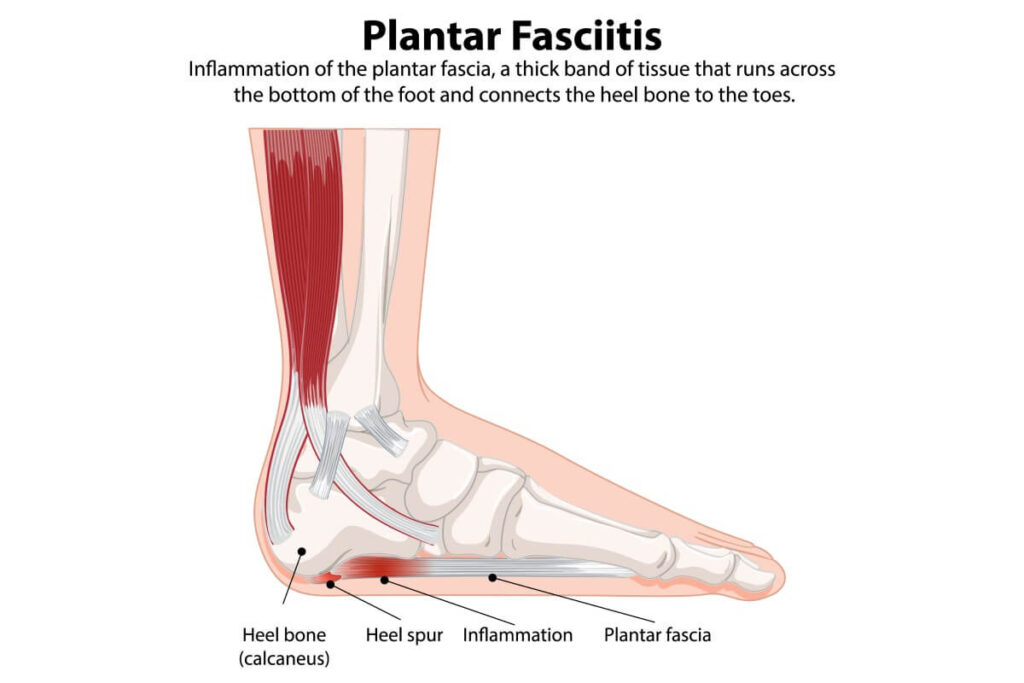
Adding tension and stress to your plantar fascia can cause inflammation, irritation, and small tears in the tissue, resulting in sharp heel pain. Long-distance running may cause plantar fasciitis – particularly in those with bad running form.
6. Runner’s Toe
The runner’s toe is a pretty much non-severe injury among runners. When this happens, it’s mainly among frequent, long-distance, and trail runners. Runner’s toe occurs to the big toe (hallux), but it’s common to appear on the other fingers, as they also experience extensive force while running.
It can occur due to repeated force of the nail at the front part of the toe that’s rubbing against the shoe. This condition generally happens when running downhill while the foot is pushed forward with each step.
Runner’s toe is also known as:
- Jogger’s toenail
- Runner’s toenail
- Subungual hematoma
- Tennis toe
7. Gout
This is a metabolic condition in which uric acid crystals accumulate in the big toe joint due to the overproduction of uric acid. When high uric acid levels crystallize, they may form small deposits, which cause pain in big toe after running.
Gout certainly causes running big toe pain in the form of flares and intense attacks. Be aware that these attacks may start during sleep, and you’ll experience pain while touching the foot with anything. They are often associated with the consumption of fatty meals and alcohol.
This condition may also occur in different body parts besides the feet, causing lumps in the affected area over time.
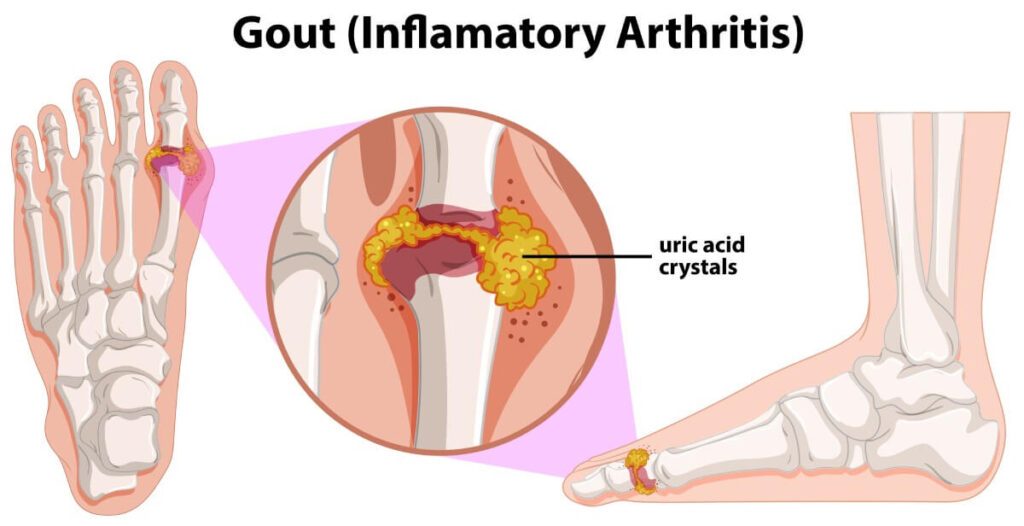
7 Main Symptoms Of The Big Toe Pain Problem After Running
After discussing the main reasons behind the pain in big toe when running, it’s essential to know how to notice it. If you’re unaware of the symptoms you’re experiencing and what they mean, you may not be able to define the underlying cause.
Your symptoms can give you at least an idea of the cause of your big toe joint pain running form. So, let’s go ahead and find out about the most common symptoms of big toe problems people are experiencing.
1. Pain
Pain is the most common symptom showing you have a problem with your big toe, and you may need runners toe treatment.
2. Restricted movement
If you find it challenging to indulge in running, walking, and engaging in activities that require putting weight on the affected area, you are experiencing a common big toe symptom.
3. Swelling
It may be another big toe symptom if your big toe joint or the surrounding area is swollen.
4. Painful toenail
Pain and tenderness in the toenail of your big toe is a symptom of something wrong in your joints.
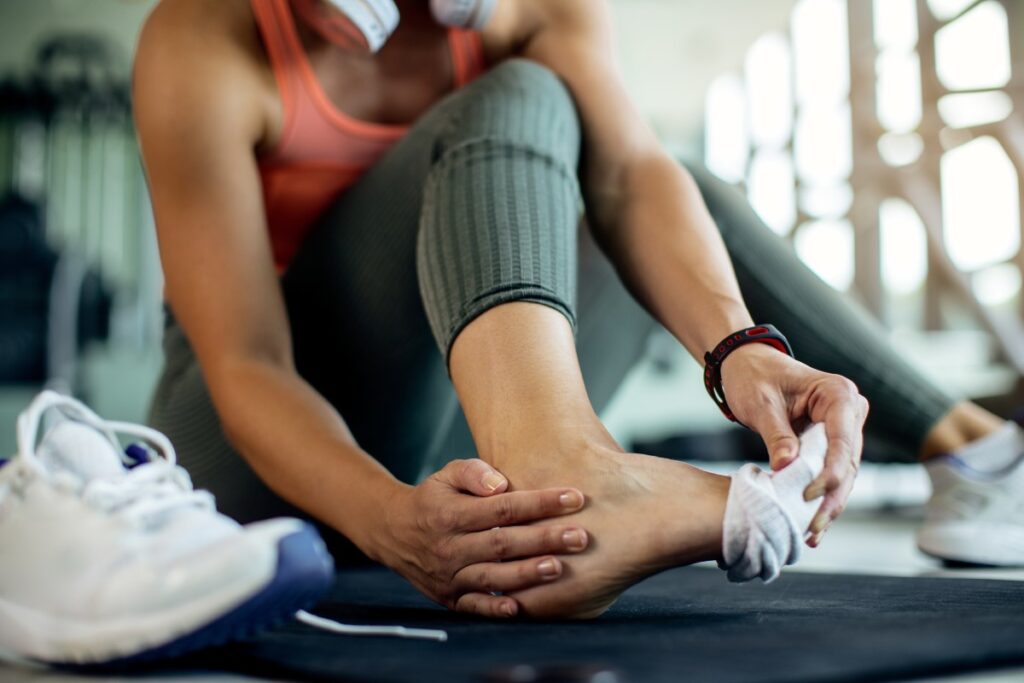
5. Deformation
Visible deformations like bunions or gouts are a symptom of a big toe problem you can’t ignore.
6. Redness
Redness is a sign of joint inflammation for big toe pain after running long distances.
7. Tingling or numbness
Pinched nerves or nerve compression in your big toe joint is a sign.
After covering the main symptoms of a big toe problem, let’s jump into the question of diagnostics and treatment.
How To Diagnose And Treat Big Toe Injury for Runners?
Once you know that there is a runner-toe treatment for each one of your symptoms, it becomes a lot easier to focus on diagnostics. Since there are so many possible causes, your priority should be figuring out the primary reason for your pain.
The diagnostics spectrum is broad, from sesamoiditis and hallux valgus to turf toe and stress fractures. Speaking of this, it’s worth saying that it may not be easy to pinpoint the problem. If you can’t figure it out independently, always seek help from a professional.
A doctor will perform a physical examination and ask questions about your symptoms, lifestyle, and recent injuries. They may test your toe’s flexibility, look for swelling, and maybe a fracture. It could be necessary for you to do an X-ray or even an MRI. This will help your doctor assess the extent and location of the deformity or damage.
The correct treatment is going to depend on your condition. Unfortunately, if you’re dealing with a big toe injury, you may need a lot of time off running, in worse cases, even immobilizing.
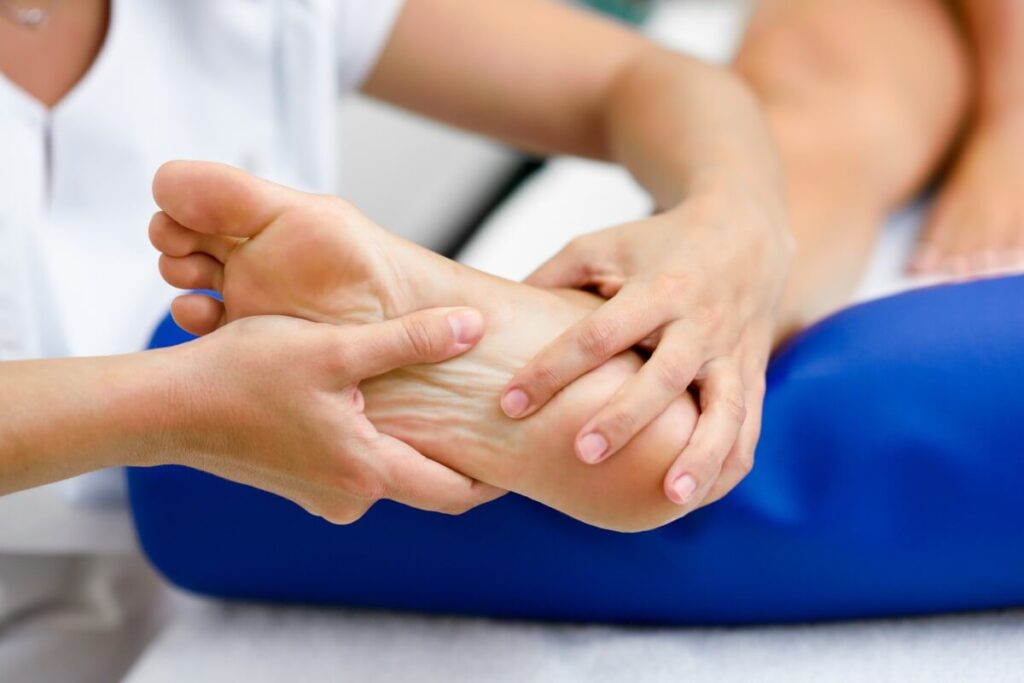
Prevention And Treatment Of Big Toe Pain When Running
You can do certain things to prevent big toe joint pain and injuries. Some of them include:
1. Regular Exercising Without Placing Excessive Strain On The MTP Joint
Regular exercise that doesn’t exert undue pressure on the MTP joint is crucial for maintaining a healthy big toe joint.
2. Maintain A Healthy Body Weight
Maintaining a healthy body weight is essential for keeping the big toe joint healthy, as excess weight can lead to joint discomfort.
3. Increase Consumption Of Vitamin C
Increased consumption of this powerful antioxidant helps reduce arthritis symptoms and protects the joint damage caused by inflammation.
4. Increase Calcium Consumption
Calcium consumption is essential in keeping your bones healthy and preventing osteoporosis.
5. Avoid Extensive Caffeine Consumption
Too much caffeine can weaken your bones, so limiting it to a certain dose is advisable.
6. Avoid Smoking At All Costs
Smoking negatively impacts your bone health and makes them prone to osteoporosis.
7. Always Wear Comfortable And Not Too-Tight Shoes
Too tight shoes can contribute to joint strain and other big toe injuries, so wear a comfortable pair.
Hoka Bondi 8
- Material: Breathable and supportive mesh upper
- Sole Material: Full-length EVA midsole for maximum cushioning
- Outsole (tread feature): Durable rubber outsole with a unique lug pattern
- Drop: 4mm
- Season: Suitable for all seasons
- Special Features: Exceptional cushioning and comfort
- Size: Available in various sizes
- Type: Maximum cushioning running shoe
If you want excellent running or walking shoes or just footwear you’ll be comfortable in, you can’t go wrong with the Hoka Bondi 8.
It’s been upgraded and now they have lighter, softer materials and a new extended heel design. The heel design gives a super soft, balanced feeling from th emoment your heel hits the ground to when you push off with your toes.
As far as the weight goes, it’s around 10.80 ounces, and the heel drop is 4 mm. They’re not too heavy and the lower drop is a good balance between cushioning and feeling connected to the ground.
The Bondi 8 is focused on cushioning and keeps things simple. There’s a good amount of support without any extra stuff that you don’t really need and that would only jack up the price. Take the rear crash pad, for example – it makes for a soft, smooth ride, which is perfect if you like to run outdoors.

The Bondi 8 is focused on cushioning and keeps things simple. There’s a good amount of support without any extra stuff that you don’t really need and that would only jack up the price. Take the rear crash pad, for example – it makes for a soft, smooth ride, which is perfect if you like to run outdoors.
The upper part is made of engineered mesh, which is breathable and keeps your feet cool and dry. The tongue and collar have memory foam and mold to your foot shape. All of these features make the fit snug but flexible, which is exactly what you would want.
The Bondi 8 is eco-friendly because it uses recyclable materials in parts like the mesh and the sockliner. Plus, the shoes are completely vegan, which (if that’s important to you) is nice!
8. Always Warm Up Before Extensive Workouts
Before engaging in extensive workouts, make sure you’re warmed up properly. Do dynamic stretches, preparing your muscles and joints for the upcoming running.
On the other hand, you can also do certain things to treat your big toe pain from running. These are simple things everyone can do at home, which will relieve your pain. Of course, if you’re dealing with unbearable and enormous pain, you should head to your doctor immediately. But let’s see the remedies that can help you manage your big toe pain after running.
9. Try Elevating Your Foot
Elevating your foot will help reduce the pain by loosening the muscles surrounding the big toe joint.
10. Rest Your Foot
You just need to take a break for a few days to reduce your big toe pain.
11. Stretch The Muscles Surrounding Your Foot
Stretching will relax your big toe joint and the surrounding muscles so that it may reduce your pain.
12. Place Pads Or Something Soft Inside Your Running Shoes
Placing pads will reduce discomfort while running and help the big toe joint relax, decreasing any pain you might have.
13. Reduce Swelling With A Compression Bandage
Compression bandages reduce swelling due to controlling fluid distribution and supporting the affected painful area.
14. Ice Your Foot For 15 Minutes Every 2 Hours
This practice will reduce inflammation, swelling, and pain in the affected area. The 2-hour intervals will give your foot enough time to warm up between icing sessions.
Is It Possible to Run With Toe Pain Or When the Big Toe Hurts?
Running with big toe joint pain is generally not recommended, as it can induce further injury and worsen your condition. Additionally, running with toe pain means a run with lower performance and bad form.
On the other hand, if we always stop running over the tiniest discomfort, most of us wouldn’t be running at all. If your big toe starts hurting during a run, you must consider a few things instead of ignoring them.
Stop for a moment and assess the pain. What is it that you’re feeling? Is it a sharp or dull pain, or are there throbbing sensations? Take a moment and look at your foot. If you see any visible damage, like a purple color and swollen finger, it may be time for you to finish the run.
Try stretching your footwear and make it as comfortable as you can. If the pain continues, try stretching the surrounding muscles and doing a tiny massage. Consider going home so you don’t risk causing even more damage to your foot.
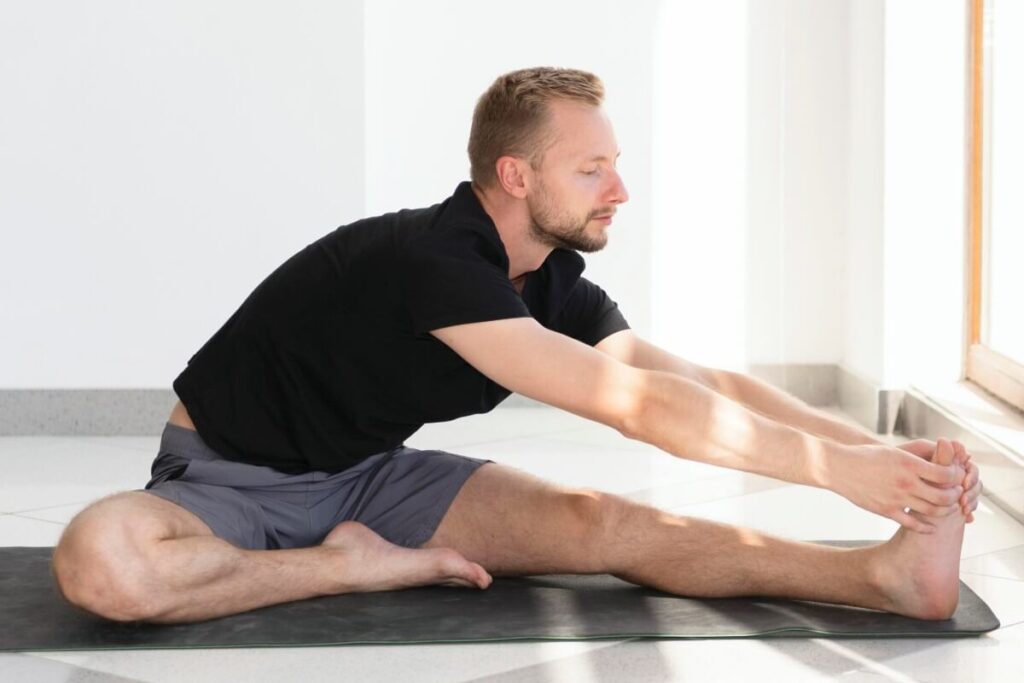
FAQ
Why Do Big Toe Hurt After Running Long Distances?
There can be multiple causes for your pain. It may be your bad running form, improper shoes, or some conditions like osteoarthritis, sesamoiditis, and bunions.
Is It Common to Experience Pain in the Big Toe While Running?
Big toe pain is uncommon in runners but might arise due to multiple underlying factors. These include footwear issues, trauma or injury, arthritis, overuse of the muscles, etc.
Conclusion
During this discussion on big toe pain, causes, and prevention, we’ve learned a lot of things. Defining the cause of your pain is essential before proceeding with treatment. Additionally, it’s important to be aware of the main symptoms and the preventive steps you can take. Does big toe pain often occur to you? How did you deal with it? Let us know in the comments!
Also read:
References:
- “Metatarsophalangeal joint”, https://radiopaedia.org/
- “Bunions”, https://orthoinfo.aaos.org/
- Preeti Kaur, Matthew R Carroll, and Sarah Stewart, “The assessment and management of sesamoiditis: a focus group study of podiatrists in Aotearoa New Zealand”, https://www.ncbi.nlm.nih.gov/
- Philip J. York, Frank B. Wydra, and Kenneth J. Hunt, “Injuries to the great toe”, https://www.ncbi.nlm.nih.gov/
- “Big toe got you down? It may be hallux rigidus”, https://www.health.harvard.edu/
- Photos are made by javi_indy, brgfx, freepik, Drazen Zigic Freepick, Staras Canvas
Why Trust Us?
With over 20 years in Olympic weightlifting, strength training, nutrition coaching, and general fitness our team does its best to provide the audience with ultimate support and meet the needs and requirements of advanced athletes and professional lifters, as well as people who strive to open new opportunities and develop their physical capabilities with us.
By trusting the recommendations of our certified experts in coaching, nutrition, and sports training programming, as well as scientific consultants, and physiotherapists, we provide you with thorough, well-considered, and scientifically proven content. All the information given in the articles concerning workout programming, separate exercises, and athletic performance, in general, is based on verified data.
The product testing process is described in more detail here.
Author: Ernesto Mendez
Orthopedic Clinical Specialist
Best Results: Snatch – 208 kg,
C&J – 240 kg
Dr. Ernesto Mendez is a licensed physical therapist, a board Orthopedic Clinical Specialist (OCS) and founder of Movement 4 Wellness Physical Therapy, LLC. He earned his degree from Thomas Jefferson University. He is also an Olympic weightlifting coach (USAW L1) and Functional Fitness Level 1 Trainer. His experience includes the areas of pain management, movement analysis, injury recovery, surgical rehab, corrective exercise, and athletic, military, and occupational performance. Dr Mendez is passionate about Olympic weightlifting and fitness. Ernesto Mendez is responsible for designing multiple training programs, writing blog articles, posting daily weightlifting content, doing live weightlifting and mobility seminars.



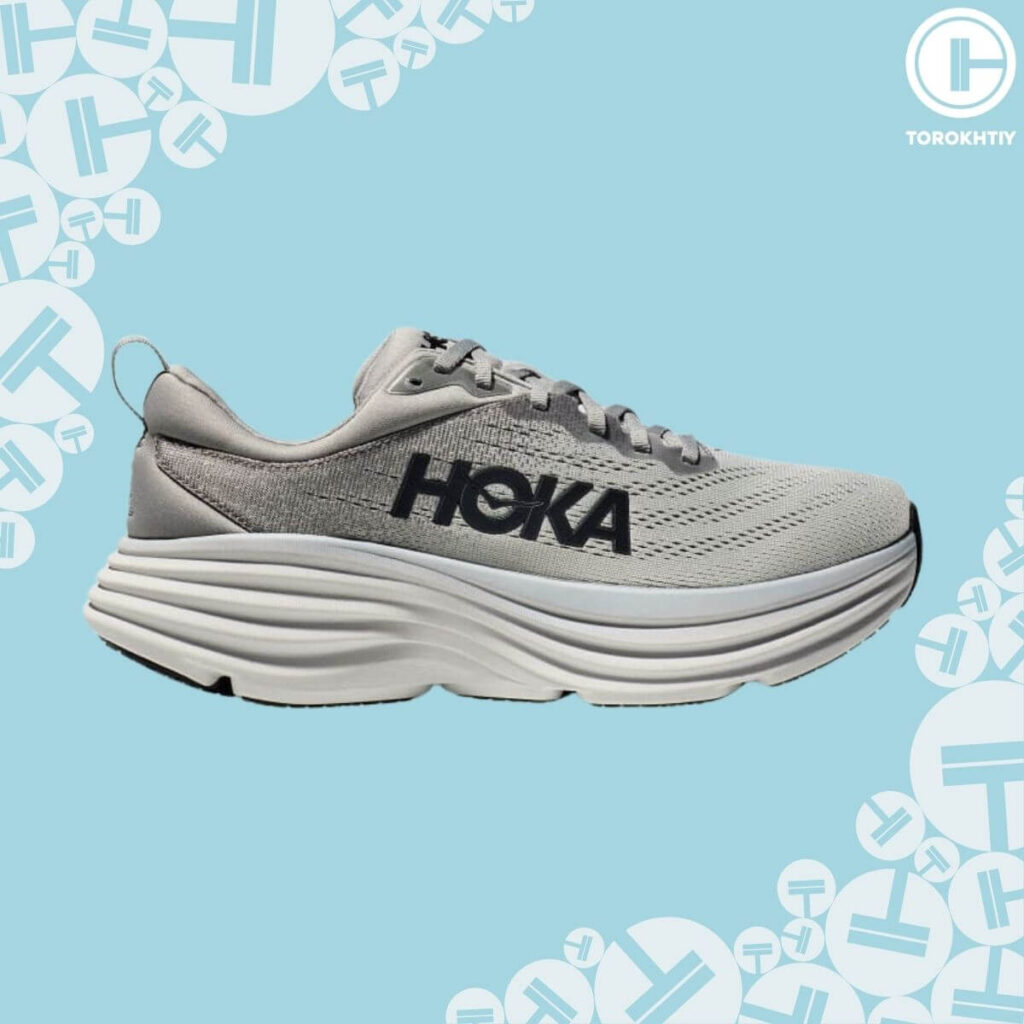
Still have questions after reading our article? Unlock your full potential by engaging with our experts and community! Don’t hesitate — leave a comment below and Ernesto Mendez will provide a personalized answer and insights to help you reach your goals.